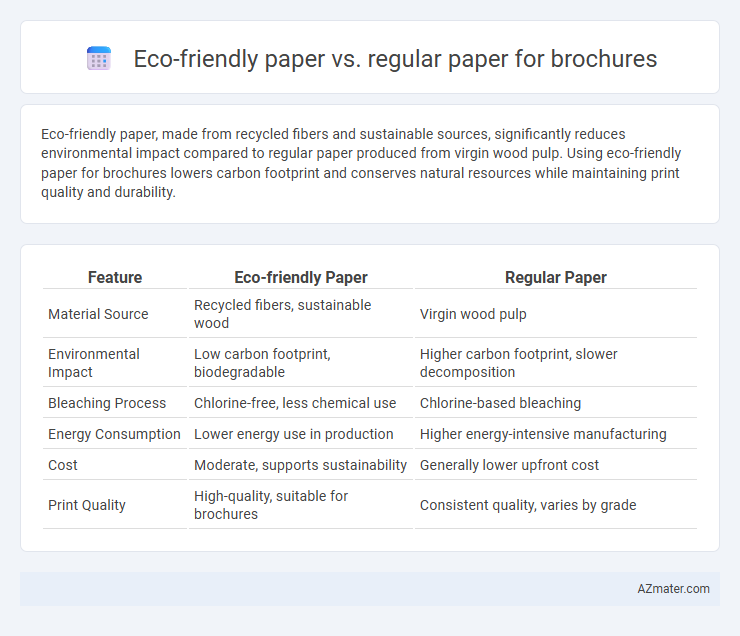Eco-friendly paper, made from recycled fibers and sustainable sources, significantly reduces environmental impact compared to regular paper produced from virgin wood pulp. Using eco-friendly paper for brochures lowers carbon footprint and conserves natural resources while maintaining print quality and durability.
Table of Comparison
| Feature | Eco-friendly Paper | Regular Paper |
|---|---|---|
| Material Source | Recycled fibers, sustainable wood | Virgin wood pulp |
| Environmental Impact | Low carbon footprint, biodegradable | Higher carbon footprint, slower decomposition |
| Bleaching Process | Chlorine-free, less chemical use | Chlorine-based bleaching |
| Energy Consumption | Lower energy use in production | Higher energy-intensive manufacturing |
| Cost | Moderate, supports sustainability | Generally lower upfront cost |
| Print Quality | High-quality, suitable for brochures | Consistent quality, varies by grade |
Introduction to Brochure Paper Choices
Choosing the right paper for brochures significantly impacts both visual appeal and environmental footprint. Eco-friendly paper options, often made from recycled fibers or sustainably sourced materials, reduce deforestation and lower carbon emissions during production compared to regular paper. Opting for biodegradable inks alongside eco-friendly paper enhances the sustainability of printed brochures, aligning marketing efforts with environmental responsibility.
What is Eco-Friendly Paper?
Eco-friendly paper is produced using sustainable practices, incorporating recycled materials and fibers from responsibly managed forests certified by organizations like FSC or PEFC. It reduces environmental impact by minimizing chemical use, water consumption, and carbon emissions compared to regular paper made from virgin wood pulp. This type of paper is ideal for brochures seeking to convey a green message while maintaining print quality and durability.
Characteristics of Regular Paper
Regular paper for brochures is typically made from virgin wood pulp, resulting in a smoother texture and brighter white finish that enhances color vibrancy and detail in printed images. It often contains chemical bleaches and additives that improve its printing performance but contribute to environmental pollution. While offering cost-effective production and consistent quality, regular paper lacks the sustainable attributes of recycled or eco-friendly alternatives, leading to higher carbon footprint and deforestation concerns.
Environmental Impact Comparison
Eco-friendly paper for brochures significantly reduces environmental impact by using sustainable materials, such as recycled fibers and non-toxic inks, which lower carbon emissions and decrease deforestation rates. In contrast, regular paper production relies heavily on virgin wood pulp, contributing to habitat loss, higher water consumption, and increased pollution. Choosing eco-friendly paper supports circular economy initiatives and minimizes landfill waste, promoting a greener, more sustainable print industry.
Production Processes: Eco vs Regular Paper
Eco-friendly paper for brochures is produced using sustainable raw materials such as recycled fibers and non-toxic dyes, minimizing environmental impact through reduced water and energy consumption. In contrast, regular paper typically relies on virgin wood pulp, chemical bleaching, and energy-intensive manufacturing processes, leading to higher carbon emissions and deforestation. The eco paper production process emphasizes biodegradability and minimal chemical usage, ensuring a greener lifecycle compared to conventional paper.
Cost Differences and Affordability
Eco-friendly paper for brochures typically costs 10-30% more than regular paper due to sustainable sourcing and manufacturing processes. While the upfront expense is higher, eco-friendly paper offers long-term value through brand differentiation and appeal to environmentally conscious consumers. Regular paper remains the more affordable option for businesses prioritizing budget, but may lack the marketing benefits associated with green materials.
Print Quality and Design Considerations
Eco-friendly paper offers excellent print quality with vibrant colors and sharp images, matching or surpassing regular paper due to advancements in sustainable pulp processing and coating technologies. Design considerations for eco-friendly brochures include selecting compatible inks and finishes to maintain environmental benefits while ensuring durability and visual appeal. Regular paper may provide more uniform texture options but often lacks the sustainable attributes crucial for environmentally conscious branding.
Durability and User Experience
Eco-friendly paper for brochures offers comparable durability to regular paper while providing enhanced resistance to wear and tear, thanks to its sustainable fibers and eco-conscious manufacturing processes. Users often prefer eco-friendly paper due to its smoother texture and reduced chemical exposure, which enhances tactile experience and visual appeal. Choosing eco-friendly paper supports sustainability goals without compromising on the brochure's longevity or customer satisfaction.
Corporate Social Responsibility and Brand Image
Eco-friendly paper for brochures enhances corporate social responsibility by reducing environmental impact through sustainable sourcing and lower carbon emissions. Brands using eco-friendly paper demonstrate commitment to sustainability, improving public perception and fostering trust among environmentally conscious consumers. This positive brand image can differentiate companies in competitive markets, aligning marketing materials with green values.
Making the Right Choice for Your Brochure
Choosing eco-friendly paper for your brochure enhances sustainability by utilizing recycled fibers and reducing environmental impact through lower carbon emissions and water usage compared to regular paper. Eco-friendly options often feature certifications like FSC or PEFC, ensuring responsible forest management and promoting brand integrity. Selecting the right paper balances quality, durability, and eco-conscious messaging, making eco-friendly paper a strategic choice for environmentally aware businesses.

Infographic: Eco-friendly paper vs Regular paper for Brochure
 azmater.com
azmater.com